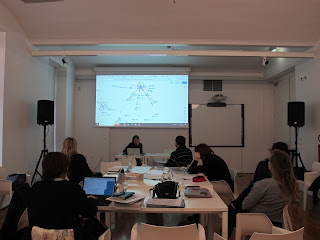Art Archives Study. Before and After 2004. Conclusion
Looking
back at the end of the two year project Art Archives Study. Before and After 2004, co-funded by the
Creative Europe Programme of the European Union, the project partners, basis wien – Documentation
Centre for Contemporary Art (Vienna, Austria), The Archive of Fine Arts (Prague,
Czech Republic), and Moderna
galerija’s Archives Department (Ljubljana, Slovenia) have drawn positive
conclusions from their endeavours.
The
decision to combine different research approaches (classical research in the
archives, oral history interviews and statistical data analysis) proved a good
one, each outcome enhancing and supporting the other, opening different
perspectives on how the EU enlargement in 2004 influenced contemporary art
practices and its context within the regions represented by the archives
Research
from the archives' collections brought to light numerous documents connected to
exhibitions that engaged with the EU enlargement.
An
overview of discussed events and material from the Archive of Fine Arts in
Prague can be found here: https://en.isabart.org/term/8277
A
portion of the research materials was also exhibited at basis wien during the
international conference I REMEMBER THIS. Documents
from the archive and library were shown in their usual storage place, using the
archival furniture and library shelves as displays. The physical materials were
contextualized by way of a room plan, linking directly to the online database
via QR codes.
To
complement and deepen the insights based on the archival research, oral history
interviews were conducted with several key figures providing different
perspectives on collaborations and connections between artists, curators,
institutions, non-governmental organisations, archives, and art markets in
an evolving context.
The
interviews were added to the archive’s holdings and databases, where they can
be accessed by researchers. In
addition, a brochure containing all 9 interviews were conducted in English during
the project was published by Moderna galerija. The publication includes a map
showcasing selected curators, artists, art critics, institutions, foundations,
venues, collections, exhibitions, and projects referenced throughout the
brochure.
The
third avenue of research was based on the three archives’ vast collections of
structured metadata acquired during decades of database-supported archiving. The queries and subsequent data analysis
provided evidence supporting the thesis that the EU enlargement has resulted in
greater artistic mobility between the respective countries, and also yielded
valuable insights into the partners' data repositories.
The
results were shared and discussed with archive professionals during the dialogical
workshop Archival Methods in Practice: Data Visualisation, Material Research
and Oral History as part of the annual meeting of European-art.net. A detailed
description of the methodology, results for each archive, visualisations and
more can be found in the downloadable brochure Art Archives Study. Before and after 2004. Queries.
With
the international conference I REMEMBER THIS the research was expanded beyond
the boundaries of the participating archives. The speakers at the conference consisted of renowned theorists,
artists, curators, and young scientists who were reached via an open call. This
group of speakers, drawn from different areas of the art field, greatly
enriched perspectives on the topic.
The
hybrid conference brought together an audience of over 80 international
scholars, artists, archivists, theorists, students and interested public at
basis wien, fostering a dynamic exchange of experiences and insights.
In
addition, the archive holdings were able to grow through this direct exchange,
for example the basis wien archive was able to greatly expand its holdings on Tanja Ostojić. An expansion that will
remain researchable beyond the duration of the project.
The
documentation of all project activities will be stored by the participating
archives and made available through their databases where possible. The insights gained by the partners over the
course of the project will also be incorporated into the development of new
databases by the partners and the collaboration of European-art.net.
Image: Visualisation of connections between exhibitions and persons using Graph Commons
Disclaimer: „Funded by the European Union. Views and opinions expressed are however those of the author(s) only and do not necessarily reflect those of the European Union. Neither the European Union nor the granting authority can be held responsible for them.“





"For reliable study abroad services, trust MR Consultant – the best study consultant in faisalabad!"
ReplyDeleteI had a great experience with MR Consultants Lahore Gulberg during my visa process. Visit this location if you want professional assistance.
ReplyDelete